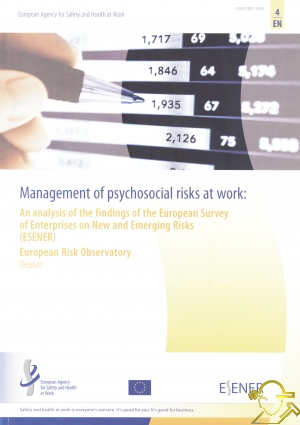European Agency for Safety and Health at Work
İÇİNDEKİLERList of abbreviations 7Foreword 9 Executive Summary 11 1. Introduction 13 1.1. Description of ESENER 13 1.2. The aim of this report 13 2. Understanding the importance of the management of psychosocial risks 14 2.1. The management of psychosocial risks over recent decades 14 2.1.1. Changes to the world of work 14 ` 2.1.2. The emergence of psychosocial risks in the workplace 15 2.2. Speciftc policy initiatives to better manage psychosocial risks 17 2.2.1. Community strategy 2007-12 on health and safety at work 17 2.2.2. Steps taken by social partners 18 2.2.3. National initiatives 19 2.2.4. Evidence on the effectiveness of policy 19 2.3. The concept of psychosocial risks and consequences for workers' health and safety 20 2.3.1. Specific psychosocial risks and their relationship to work characteristics 20 2.3.2. Psychosocial risks and physical and mental health 21 2.3.3. The specific impact of psychosocial risks on stress experienced by workers 21 2.3.4. Work-related stress and the emergence of physical and mental health disorders 25 2.3.5. The costs of a poor psychosocial work environment 27 2.4. The risk management paradigm and managing psychosocial risks 27 2.4.1. The use of the risk management paradigm 27 2.4.2. Questions around the applicability ofthe risk management paradigm for psychosocial risks 28 2.4.3. The use of risk management approaches by stakeholders 28 2.5. Summary 28 3. Towards a conceptual framework for managing psychosocial risks 29 3.1. A conceptual framework for psychosocial risk management 29 3.2. The conceptual model and the empirical work on the ESENER data 31 3.3. Summary 32 4. Analysing the ESENER data on managing psychosocial risks 32 4.1. The empirical analysis using factor analysis 32 4.1.1. A systemic approach to the management of psychosocial risks 33 4.1.2. A composite index of the management of psychosocial risks 33 4.2. The characteristics of establishment and their relationship to the Composite index 34 4.2.1. Country context, size and industry and the management of psychosocial risks 34 4.2.2. The size ofthe establishment and psychosocial risk management 35 4.2.3. Industries and reporting of aspects of psychosocial risk management 36 4.2.4. Reporting of aspects of psychosocial risk management and country context 36 4.2.5. Independent and private establishments and reported numbers of psychosocial risk management measures 37 4.2.6. The composition of the workforce and reporting of psychosocial risk management measures 37 4.2.7. The importance ofthe country context in determining the presence of effective psychosocial risk management 38 4.2.8. Looking in more detail at components of the OSH__psycho index 39 4.3. Additional findings 42 4.3.1. The management of psychosocial risks compared to the general management of OSH 42 4.3.2. The employees' and managers' perspectives in ESENER 42 4.4. Summary 43 5. Discussion of what the survey can tell us 44 5.1. Inherent limitations ofthe survey 44 5.1.1. Common weaknesses in surveys like ESENER and the empirical analysis undertaken 44 5.1.2. The coverage in the survey of questions on the management of psychosocial risks 44 5.1.3. Outcome information in ESENER 44 5.1.4. ESENER and informal procedures and organisational culture 45 5.2. Summary 45 6. Towards policy recommendations 46 6.1. Main findings 46 6.1.1. The use of systemic approaches and developing an index for psychosocial risk management 46 6.1.2. The frequency of measures to manage psychosocial risks 46 . 6.1.3. Size 47 6.1.4. Practice in industry 47 6.1.5. Country context 48 6.1.6. Establishment's demographics 49 6.1.7. An index for psychosocial risk management and outcomes on workers' health and well-being in ESENER 49 6.1.8. ESENER and the perspectives of employee representatives and managers 50 6.2. Summary 50 7. References 51    |



